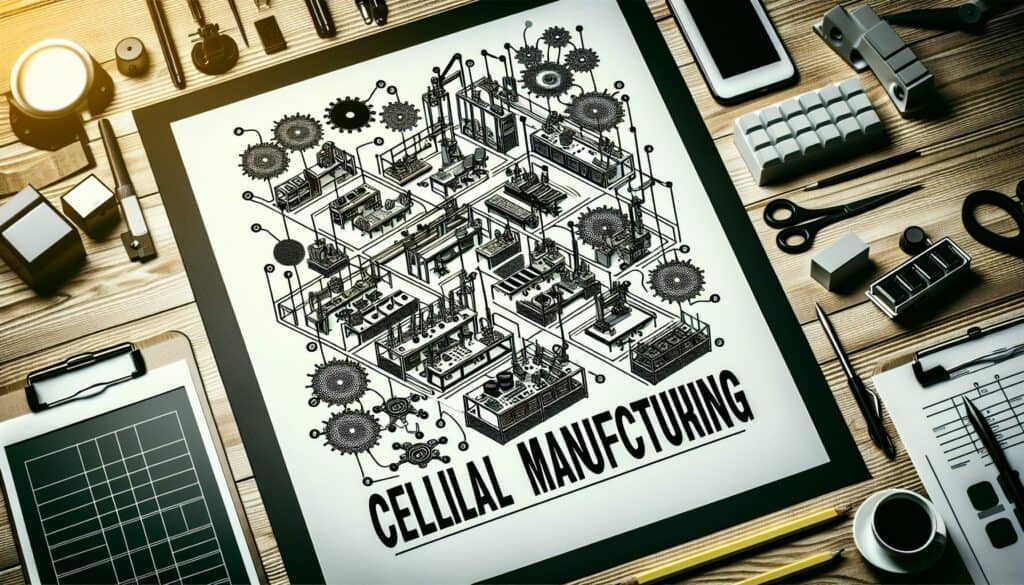Verbesserung der Produktionseffizienz durch Gruppierung unterschiedlicher Maschinen in Zellen, die Produkte mit ähnlichen Bearbeitungsanforderungen (Teilefamilien) bearbeiten.
- Methodologien: Maschinenbau, Ergonomie
Zelluläre Fertigung

Zelluläre Fertigung
- Kontinuierliche Verbesserung, Just-in-Time (JIT), Schlanke Fertigung, Prozessverbesserung, Produktionseffizienz, Qualitätsmanagement, Wertstrom-Mapping
Zielsetzung:
Wie es verwendet wird:
- Die Arbeitsplätze und Ausrüstungen sind in einer Reihenfolge angeordnet, die einen reibungslosen Material- und Komponentenfluss durch den Produktionsprozess mit minimalem Transport und Verzögerung ermöglicht. Eine Zelle ist für die Herstellung einer Familie ähnlicher Teile zuständig.
Vorteile
- Reduziert den Bestand an unfertigen Erzeugnissen, die Durchlaufzeiten und den Materialumschlag; verbessert die Flexibilität, die Arbeitsmoral und die Qualität; spart Platz in der Fabrik.
Nachteile
- Kann kostspielig in der Umsetzung sein (Umstellung der Ausrüstung, Schulung); erfordert sorgfältige Planung und Identifizierung der Teilefamilien; die Maschinenauslastung innerhalb einer Zelle kann geringer sein, wenn sie nicht richtig ausbalanciert ist; anfällig für Ausfälle, wenn eine Maschine in einer Zelle ausfällt.
Kategorien:
- Lean Sigma, Herstellung, Produktdesign
Am besten geeignet für:
- Verbesserung des Durchflusses und der Effizienz in der Produktion von hochwertigen Produkten mit geringem bis mittlerem Volumen durch die Schaffung spezieller, fokussierter Produktionseinheiten.
Cellular manufacturing is particularly effective in industries such as automotive, electronics, and appliance manufacturing, where product lines often consist of a variety of components requiring customized assembly processes. This methodology is most beneficial during the design and development phases of new products, where early collaboration among engineers, designers, and production teams can lead to more efficient workflows. The implementation of cellular manufacturing typically begins with a thorough analysis of the product family to identify similarities and group related components, which enables the design of cells that can efficiently deal with variations in production. Participants including production supervisors, quality assurance personnel, and manufacturing engineers are crucial in defining the specific tasks and responsibilities within each cell. This collaborative approach not only enhances communication among team members but also fosters a sense of ownership and accountability, leading to improved worker morale. Furthermore, the layout of the production area can facilitate better ergonomic practices and minimize operator fatigue, which in turn translates to higher quality outputs and lower defect rates. Companies that incorporate cellular manufacturing may use techniques such as just-in-time inventory and Lean-Prinzipien to further enhance productivity, thereby reducing costs associated with excess inventory and prolonging lead times. Continuous improvement initiatives, like Kaizen, are often applied alongside cellular manufacturing, allowing teams to regularly assess and refine their processes to stay competitive in fast-paced markets.
Die wichtigsten Schritte dieser Methodik
- Identify the family of similar parts to be produced.
- Design the cellular layout considering the workflow and space efficiency.
- Group equipment and workstations based on the sequence of operations needed.
- Assign team members to specific roles within the cell based on skill sets.
- Implement standardized work procedures for each operation within the cell.
- Establish visual controls and tools to monitor workflow and quality.
- Conduct regular reviews and adjustments based on performance and feedback.
- Train staff on cell operation and encourage cross-training for flexibility.
- Iterate designs and processes based on efficiency metrics and product quality.
Profi-Tipps
- Analyze process flow regularly to identify bottlenecks and balance workloads across workstations for optimal efficiency.
- Implement cross-training for workers to enhance flexibility, allowing easy movement between tasks and cells as demand fluctuates.
- Utilize performance metrics to assess cell effectiveness continuously, adjusting layout and resources based on real-time production data.
Verschiedene Methoden lesen und vergleichen, Wir empfehlen die
> Umfassendes Methoden-Repository <
zusammen mit den über 400 anderen Methoden.
Ihre Kommentare zu dieser Methodik oder zusätzliche Informationen sind willkommen auf der Kommentarbereich unten ↓ , sowie alle ingenieursbezogenen Ideen oder Links.
Historischer Kontext
1949
1950
1950
1960
1960
1960
1960
1940
1950
1950
1958
1960
1960
1960
1960
(wenn das Datum nicht bekannt oder nicht relevant ist, z. B. "Strömungsmechanik", wird eine gerundete Schätzung des bemerkenswerten Erscheinens angegeben)















Verwandte Artikel
Fragebögen zu muskuloskelettalen Beschwerden
Multivariate Tests (MVT)
Mehrfache Regressionsanalyse
Motion-Capture-Systeme
MoSCoW-Methode
Moods Median-Test